Uniden LRD6299SWS, LRD6399SWS Manual

Introduction
Welcome to the world of sophisticated, early warning laser/radar detection. You have purchased one of the most advanced laser/radar detectors available. The LRD 6299SWS/LRD 6399SWS is a complete integrated laser/radar detector. It responds to the X-, K-, and Ka-SuperWideband radar guns in use today and also provides 360° detection of the latest speed monitoring system — the laser gun. The built-in Safety Warning System (SWS™) is capable of detecting a hazardous warning signal transmitted on the K-band.
The LRD 6299SWS/LRD 6399SWS provides distinct visual and audio alerts to warn you of the presence of X-, K-, and Ka-SuperWideband radar signals as well as IR laser signals. You can drive with confidence when you bring along the LRD 6299SWS/LRD 6399SWS.
The LRD 6299SWS/LRD 6399SWS employs Super Stalker Technology (SST), a state-of-the-art electronic system designed to make this radar detector invisible to all current VG-2 radar detector detectors. The
LRD 6299SWS/LRD 6399SWS also uses the new D.R.O. (Dielectric Resonant Oscillator) and E.D.I.T. (Electronic Data Interference Terminator) circuitry, giving more reliable performance.
We are certain that you will enjoy the LRD 6299SWS/LRD 6399SWS, and to ensure that you get the most from its features, please read this Operating Guide carefully before installing and operating the unit.
Feature Highlights
∙ 360° Laser Detection |
∙ Safety Warning System™ |
∙ Complete 4-Band Coverage |
∙ 4 Alarm Tones |
∙ Super Wideband |
∙ VG-2 Undetectable |
∙ K/Ka Priority |
∙ Pulse Detection |
∙ Signal Strength Meter |
∙ Warning Lights |
∙ Visual Only Mode |
∙ Auto Mute Mode |
∙ Audio Only Mode |
∙ Self Test |
∙ Memory Retention Feature |
∙ City and Highway Modes |
1

Speed Detection Systems
A speed detection device (often called a radar gun) sends out either a microwave signal or beam of light. When this signal reaches its target, part of the signal is reflected or bounced back toward the emitting gun. The time required for the signal to leave the gun, bounce off an object, and return is used to determine a vehicle’s distance and speed.
Radar
Radar (Radio Detection and Ranging) is a microwave system for detecting the speed of moving objects by reflected pulses of high frequency radio waves. There are 3 radar bands (microwave frequencies): Xband (10.49 to 10.56GHz), Kband (24.04 to 24.26GHz), and the “superwide” Ka band (33.4 GHz to 36 GHz).
The X band was the first used for traffic, followed by the K band which is harder to detect (most instant-on radar is K band). The Ka band was introduced in 1987, and widened to Ka SuperWideband in 1990 by the FCC. The LRD 6299SWS/LRD 6399SWS monitors all current radar bands including the entire Ka SuperWideband.
The radar beam is cone shaped — the narrower the beam, the greater the resolution. A moving vehicle reflects radar signals back towards the radar gun. The LRD 6299SWS/LRD 6399SWS can detect the signals emitted by radar guns, and it will sound an audio alarm and flash a warning indicator.
For continuously transmitting radar, use the LRD 6299SWS/LRD 6399SWS to get accurate detection from a safe distance. Weak signals cause the audio and visual alarms to sound intermittently, but as the signal gets stronger (the closer you get to the radar gun), both alarms increase in intensity.
Instant-on transmitters fire a short radar pulse beam at a vehicle and instantly read its speed. When detected at a distance, you will hear a few beeps and see the strength meter begin to light. Instant-On radar signals are the most difficult to detect at a safe distance because they are transmitted only when directed at you or at a vehicle directly ahead of you.
2
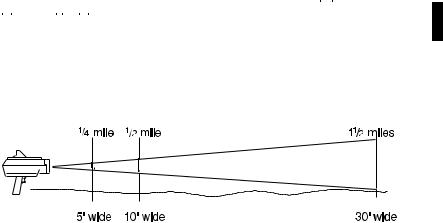
Laser
The Laser Speed Detection System, also called LIDAR (for Light Detection and Ranging), uses a laser gun that emits infrared light pulses just outside the spectrum of visible light. Each reflected pulse measures the speed of the object coming toward or going away from the laser gun.
Unlike radar, the laser gun emits a very narrow beam of light, so it can pinpoint a speeding car within traffic. The infrared beam spreads out, but slowly and over a longer distance than a radar signal.
The laser gun can acquire a speed reading as quickly as 0.3 seconds, sometimes less. However, since it isn’t easy to accurately aim at and hit a moving target, an operator often moves the laser gun in several directions to get a reading. So laser signals are emitted continuously for a few seconds for each speed measurement. The LRD 6299SWS/LRD 6399SWS can detect these light pulses from as far away as 1.5 miles, which is about four times the effective range of a laser gun (2,000 feet), and about ten times its average operating range (500-800 feet).
Note: To be safe, do not ignore any warnings. Although there are other types of radar signals that may cause interference, when the LRD 6299SWS/LRD 6399SWS detects a signal, be on the alert. It is important to exercise caution at all times.
3
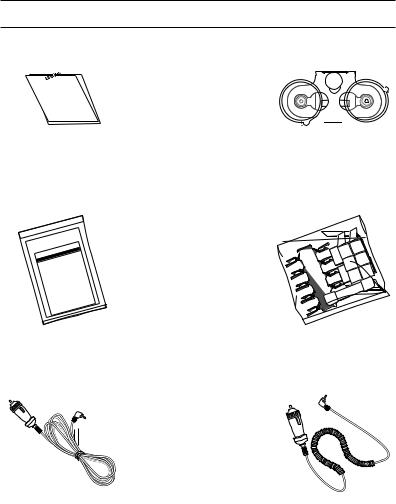
Included with Your Radar Detector
Laser/Radar |
Detector |
|
|
|
|
|
|
|
|
||
Guide |
|
|
|
|
|
Operating |
|
|
|
|
|
|
|
|
|
|
|
Owner’s Guide |
Windshield |
||||
Clip |
|||||
|
|
|
|
||
|
njdfjnjnjfnjfjn |
|
|||
|
jnkjnjksnkjsnfj |
|
|||
njdfjnjnjfnjfjn |
dfksfmkm |
|
|||
kfmkmkmlf |
|
||||
jnkjnjksnkjsnfj |
|
sfkkmmfmsmsm\ |
|
||
dfksfmkm |
|
kkoioionksnkln |
|
||
kfmkmkmlf |
|
njdfjnjnjfnjfjnmmkmkkl |
|
||
sfkkmmfmsmsm\ |
|
jnkjnjksnkjsnfjskdmkmkm |
|
||
kkoioionksnkln |
|
dfksfmkmsdmkmfmmmk |
|
||
njdfjnjnjfnjfjn |
|
|
kfmkmkmlf |
|
|
mmkmkkljnkjnjksnkjsnfj |
|
|
sfkkmmfmsmsm\mdmklkkkml |
|
|
skdmkmkmdfksfmkm |
|
|
kkoioionksnklnmmkkllmmk |
|
|
sdmkmfmmmkkfmkmkmlf |
|
|
mmkmkkl |
|
|
sfkkmmfmsmsm\ |
|
|
skdmkmkmnjdfjnjnjfnjfjn |
|
|
mdmklkkkml |
|
|
|
||
kkoioionksnkln |
|
|
sdmkmfmmmkjnkjnjksnkjsnfj |
|
|
mmkkllmmkmmkmkkl |
|
|
mdmklkkkml |
|
|
skdmkmkm |
|
|
dfksfmkm |
|
|
|
|
mmkkllmmk |
|
||
njdfjnjnjfnjfjnsdmkmfmmmk |
|
|
kfmkmkmlf |
|
|
jnkjnjksnkjsnfjmdmklkkkml |
|
|
njdfjnjnjfnjfjn |
|
|
njdfjnjnjfnjfjn |
|
|
jnkjnjksnkjsnfjsfkkmmfmsmsm\ |
|
|
|
|
dfksfmkmkkoioionksnkln |
|
||
dfksfmkmmmkkllmmk |
|
|
|
|
|
kfmkmkmlf |
|
|
kfmkmkmlfmmkmkkl |
|
|
sfkkmmfmsmsm\jnkjnjksnkjsnfj |
|
sfkkmmfmsmsm\ |
|
||
dfksfmkm |
|
|
kkoioionksnklnskdmkmkm |
|
|
kkoioionksnklnkfmkmkmlf |
|
mmkmkklsdmkmfmmmk |
|
||
mmkmkklsfkkmmfmsmsm\ |
skdmkmkm |
|
|||
kkoioionksnkln |
mdmklkkkml |
|
|||
skdmkmkm |
|
|
sdmkmfmmmk |
|
|
mmkmkkl |
|
|
mmkkllmmk |
|
|
sdmkmfmmmk |
|
mdmklkkkml |
|
||
skdmkmkm |
|
mmkkllmmk |
|
||
mdmklkkkmlsdmkmfmmmk |
|
|
|||
mmkkllmmkmdmklkkkml |
|
|
|||
mmkkllmmk |
|
|
|||
Printed |
Fuses and |
||||
Material |
Spare Parts |
||||
Straight Power Cord
Coiled Cigarette
LRD 6299SWS Only
Adapter
LRD 6399SWS Only
If any of these items are missing or damaged, contact your dealer immediately. Be sure to complete and mail the Product Registration Card.
4
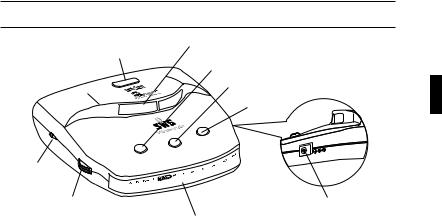
Controls and Functions
1 2
3 4
5
MUTE
AUDIO
Y
CIT
9
8
7
DC12V
6
1.Clip Release — Press the clip release button to remove the LRD 6299SWS/LRD 6399SWS from the windshield mounting clip.
2.Rear and Side Laser Detector Lenses — For rear and side detection of laser signals.
3.City Button — Press the CITY button to help reduce X-band false alarms while driving in the city. When you turn on the City Mode, the City indicator turns on. While driving on highways, turn off the City Mode for long-range detection.
4.Audio Button — Press the AUDIO button to activate the Audio Alert Only operation. All the LEDs dim, and the signal strength meter is disabled.
Note: To operate with visual alert only, set the volume control to the minimum. Remember though, that if the volume control is turned down and Audio Only operation is selected, the alarm features are completely disabled.
5.Mute Button — Press the MUTE button to activate the Auto Mute feature, which produces a full alert level when a signal is first received, then automatically reduces to half volume for the rest of the warning.
6.DC 12V Power Input — Connect the DC power cord here.
Note: Use on a Uniden® supplied power cord or its replacement.
5
7.LED Display — LEDs display visual alerts, signal strength, and operation mode.
8.On-Off/Volume Control — Turns the power on and adjusts the Audio Alert volume.
9.Speaker — Sounds audio alert. There are four different audio alert tones to distinguish each type of signal received. When you become familiar with all the distinct alert tones, you can operate the LRD 6299SWS/LRD 6399SWS just by listening, devoting your full attention to the traffic in front of you.
6
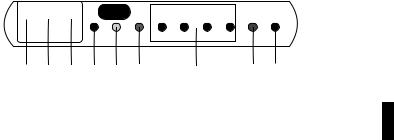
X K Ka L SWS P 1 2 3 4 C M
1 |
2 |
3 |
4 |
5 |
6 |
7 |
8 |
9 |
1.X-Band Signal Indicator — A green LED lights and blinks to indicate the presence of an X-band radar signal. The blink rate increases as the radar source gets closer. A distinct audio alert is also heard.
2.K-Band Indicator — An amber (orange) LED lights and blinks to indicate the presence of a K-band radar. The blink rate increases as the radar source gets closer. A distinct audio alert is also heard.
3.Ka-SuperWideband Signal Indicator — A yellow LED lights and blinks to indicate the presence of a Ka-SuperWideband radar signal. The blink rate increases as the radar source gets closer. A distinct audio alert is also heard.
4.Laser Signal Indicator — A red LED under L lights and blinks to indicate the presence of a laser signal. A distinct audio alert is also heard.
5.SWS Signal Indicator — When an early warning hazard or informational signal is detected, the yellow SWS LED begins to blink and the amber K-band LED lights. A distinct audio alert is also heard.
6.Power-On Indicator — A green LED under P lights to indicate power is being supplied to the unit and the unit is turned on.
7.LED Signal Strength Meter — Four LEDs give an accurate visual indication of the strength of radar or laser signals.
8.City Mode Indicator — A green LED under C lights to indicate that you selected City Mode.
9.Auto Mute Indicator — A red LED under M lights to indicate that you selected the Auto Mute feature.
Note: Every time you turn on the LRD 6299SWS/LRD 6399SWS, a self-test is performed for all LEDs and Alert tones. You will hear in-order four distinct tones for the X-, K-, and Ka-SuperWideband radar bands, as well as for laser.
7
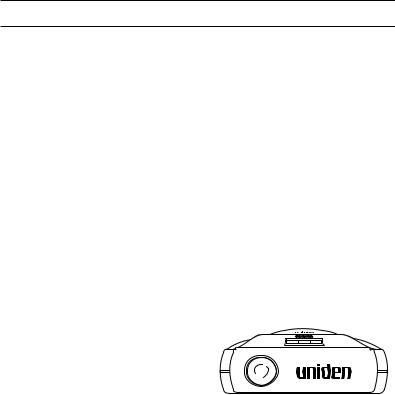
Installation
The LRD 6299SWS/LRD 6399SWS uses a highly sensitive horn-type antenna and IR laser sensor to receive radar/laser signals. Its sensitivity and range depend on the method of installation and the direction of the antenna/sensor in relation to the signal source. The inherent nature of radar waves makes them reflect off metallic surfaces. This is why these waves are so useful for measuring the speed of a vehicle. The IR laser light may reflect only from shiny surfaces. Both radar waves and IR laser light will, however, pass through plastic or glass.
Before you decide where to put your radar detector, please keep in mind these two important factors:
∙For safety, do not mount the LRD 6299SWS/LRD 6399SWS in a location where it will obstruct your driving vision.
∙Most vehicles have the top part of the windshield tinted. Mounting the LRD 6299SWS/LRD 6399SWS behind tinted or mirrored glass may reduce the effectiveness of laser detection by reducing the amount of laser light received by the Detector.
Helpful Tips
The antenna and the forward looking sensor are located behind the rear panel of the unit, (and the rearand side-looking sensors are located on top of the unit), directly behind the mode selection keys. The antenna and sensors should not be obstructed by metal or metallic surfaces and should be pointed at the horizon for accurate long-range detection.
∙Do not mount the unit behind the windshield wiper blades, radio antenna, tinted glass area, or mirrored glass. Be sure the unit is free from obstruction by seat backs, rear view mirror, sun visors, or the ceiling of the automobile.
∙Do not mount the unit in front of the heater or defroster vents.
∙Do not leave the unit in direct sunlight or in the glove compartment of a closed car for long periods of time, as extreme changes in temperature may cause internal damage. Also, removing the unit from the windshield makes you less susceptible to break-in and theft.
8
